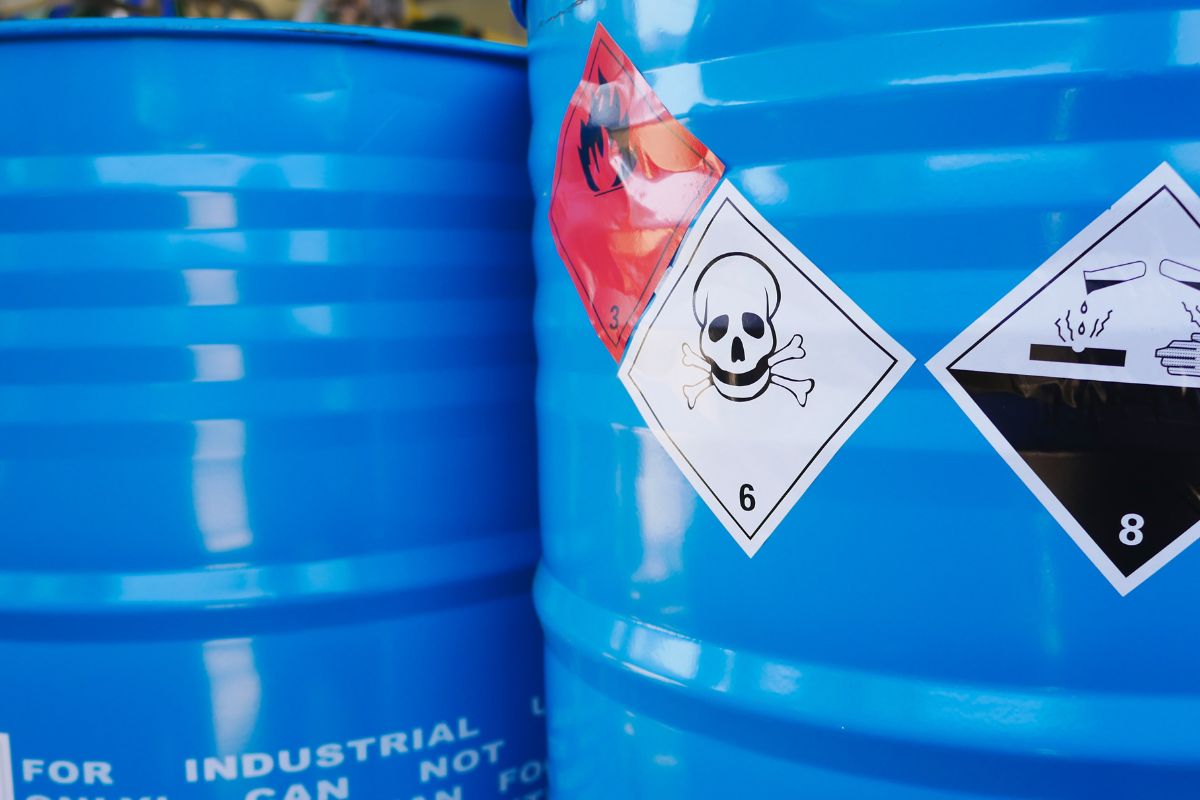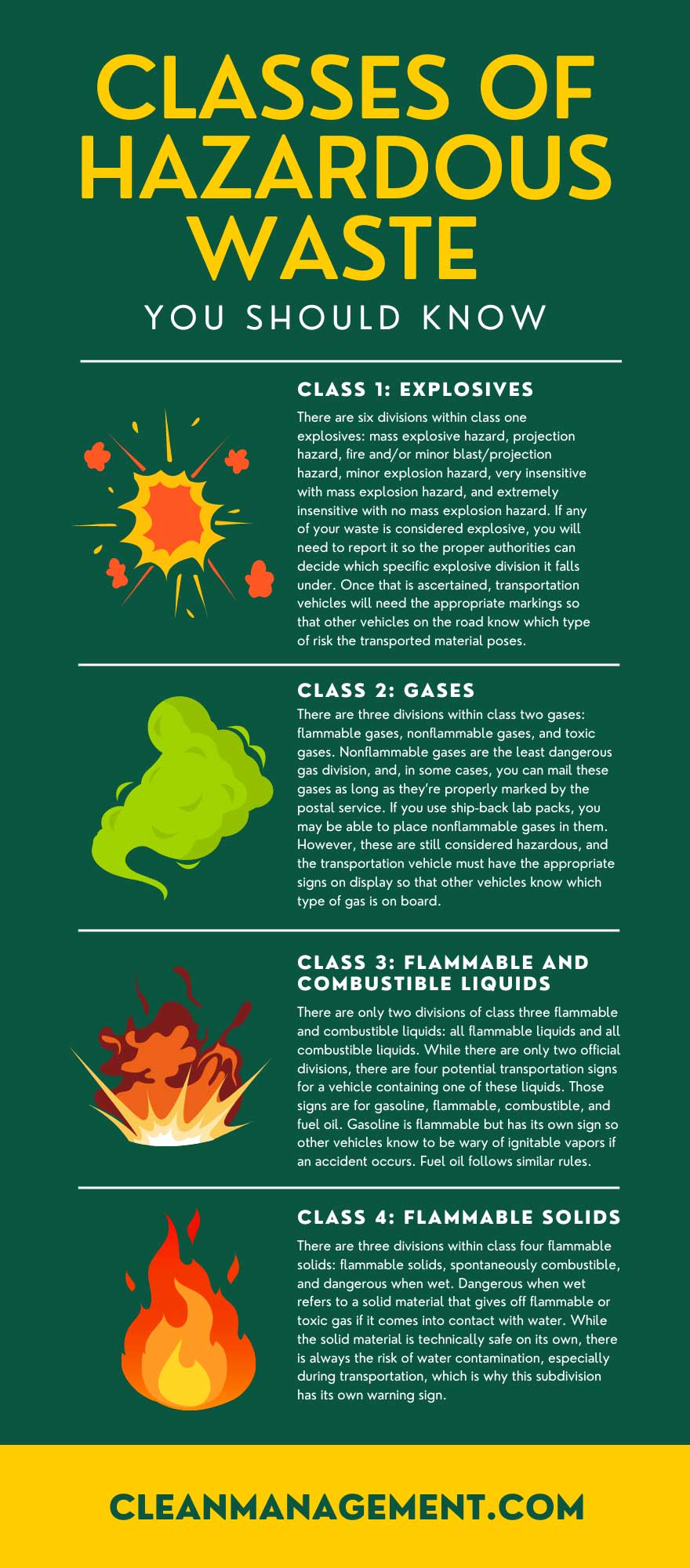9 Classes of Hazardous Waste You Should Know

The US government closely regulates anything that could harm people, animals, or the environment; this includes hazardous waste. If you work with waste in any capacity, especially in transportation, then you must be aware of these regulations so you can stay safe while protecting the public and the environment. In particular, part of those protective regulations you should know about are the nine classes of hazardous waste. Each class describes a specific kind of waste, and you’ll probably need to transport each type of waste differently or hire someone to do it for you. Continue reading to learn about these classes so you know which type of waste you’re working with.
Class 1: Explosives
There are six divisions within class one explosives: mass explosive hazard, projection hazard, fire and/or minor blast/projection hazard, minor explosion hazard, very insensitive with mass explosion hazard, and extremely insensitive with no mass explosion hazard. If any of your waste is considered explosive, you will need to report it so the proper authorities can decide which specific explosive division it falls under. Once that is ascertained, transportation vehicles will need the appropriate markings so that other vehicles on the road know which type of risk the transported material poses.
Class 2: Gases
There are three divisions within class two gases: flammable gases, nonflammable gases, and toxic gases. Nonflammable gases are the least dangerous gas division, and, in some cases, you can mail these gases as long as they’re properly marked by the postal service. If you use ship-back lab packs, you may be able to place nonflammable gases in them. However, these are still considered hazardous, and the transportation vehicle must have the appropriate signs on display so that other vehicles know which type of gas is on board.
Class 3: Flammable and Combustible Liquids
There are only two divisions of class three flammable and combustible liquids: all flammable liquids and all combustible liquids. While there are only two official divisions, there are four potential transportation signs for a vehicle containing one of these liquids. Those signs are for gasoline, flammable, combustible, and fuel oil. Gasoline is flammable but has its own sign so other vehicles know to be wary of ignitable vapors if an accident occurs. Fuel oil follows similar rules.
Class 4: Flammable Solids
There are three divisions within class four flammable solids: flammable solids, spontaneously combustible, and dangerous when wet. Dangerous when wet refers to a solid material that gives off flammable or toxic gas if it comes into contact with water. While the solid material is technically safe on its own, there is always the risk of water contamination, especially during transportation, which is why this subdivision has its own warning sign.
Class 5: Oxidizing Substances and Organic Peroxides
Class five oxidizing substances and organic peroxides only have two divisions: oxidizing substances and organic peroxides. An oxidizing substance is dangerous because when it receives an electron from another substance, it can combine oxygen with another material and cause a fire or explosion. The bonds within an organic peroxide can easily break and cause a similar hazard, which is why these two are grouped together.
Class 6: Toxic Substances and Infectious Substances
The two divisions within class six are the namesake of the class: toxic substances and infectious substances. However, the transportation symbols for vehicles to display use different wording to warn other vehicles of these materials. The label may say poison, inhalation hazard, infectious substance, or PG III. Poison indicates a substance that is poisonous but is not an inhalation hazard. PG III indicates a poisonous substance weighing over 1,001 pounds. You might also need a biohazard sign depending on where the toxic substance or infectious substance is coming from.
Class 7: Radioactive Material
There are no subdivisions within radioactive material, and there is only one radioactive sign for transportation. Radioactivity refers to the instability of the atoms within a material, which is often caused by excessive internal energy within the nucleus of each atom. Exposure to radioactivity is dangerous as it can cause short-term health problems, such as burns, and long-term health problems, such as cancer. Radiation can also affect air, soil, water, plants, animals, and buildings, soaking into the bodies or materials and causing health problems for nearby living organisms.
Class 8: Corrosives
Class eight corrosives are corrosive liquids and solids, although these different states of matter do not receive their own subdivisions. Corrosives also only have one transportation label. While broad, the corrosive label refers to any chemical that will dissolve the structure of an object it touches. Corrosives can rapidly destroy human cells and tissues, which is why it’s so important to properly label this waste for transportation.
Class 9: Miscellaneous Hazardous Materials
Miscellaneous hazardous materials have one transportation sign since this is a complicated class. Anything that is hazardous but doesn’t fit within the specific parameters of classes one through eight will fall under this class. Some examples of materials that fit into this broad category include asbestos, car airbags, first aid kits, and sulfur. Each of these materials requires its own specific kind of disposal, which is why many businesses hire waste management companies to handle them properly.
If you work with hazardous waste, you should know the nine classes described above. Even if you only work with one class of hazardous waste, knowing about the other classes is beneficial. Understanding class nine is especially helpful since it acts as a catch-all for confusing hazardous waste that doesn’t fit into a specific category.
After learning more about these hazardous waste classes and the special signs they need for safe transportation, you will know exactly what to tell the waste management company when you hire them. Clean Management Environmental Group provides specialized waste disposal and is happy to work with you to manage your business’s hazardous waste transportation and disposal needs. Our company has over 150 years of experience handling waste, so you know you’re getting expert help. We also offer transportation and disposal services for non-hazardous materials, so you can trust one company to handle all of your waste. Contact us for a free quote regarding our quick, nationwide service that will never hold you to a contract. We look forward to helping you.

